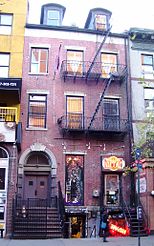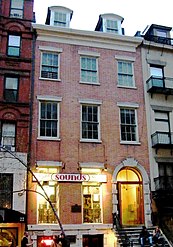Thomas E. Davis
Thomas E. Davis (c1785-1878)[1] was a prolific real estate developer who built residential properties in New York between 1830 and 1860.
Davis emigrated from England to New Brunswick, New Jersey, with the intention of setting up a distilling business. When this failed he moved to New York, and with financial backing from banking brothers, J. L. & S Josephs, began a career in property speculation. In 1831 he built terraces of Federal style houses on East 8th Street, between Third & Second Avenue called St Mark’s Place.[2] Further developments in the area included Carroll Place, on the block from Thompson Place to Laguardia Place.[3]
Between 1834 and 1835, Davis bought land on Staten Island, that ran from the quarantine station to Sailors' Snug Harbor. He called the area New Brighton (after a coastal resort in England) and built Greek revival style houses on the shoreline.[4] An association of wealthy entrepreneurs was set up to further develop the land and promote the area as a suburb, with easy access to New York via steam ferries. However, almost immediately the financial crisis of 1837 resulted in foreclosure of the association. Davis, with co-partners, re-acquired the development and managed to ride out the recession. Davis lost a substantial amount of money during this period but survived the crash, however, the banking brothers, J. L.& S Josephs, who had initially provided support for Davis failed.
Towards the end of the recession Davis was able to purchase 400 plots on Fifth Avenue (north of Twentieth Street) for a few hundred dollars each and built a complete block of fine dwellings between East 31st and East 32nd Street.[5]
Davis became extremely wealthy; the real estate owners’ list of the period placed Astor as number 1, A. T. Stewart 2nd and Thomas E. Davis 3rd.[6] In the mid 1860s Davis moved with his family to Italy. He died in Florence 16 March 1878 aged 93.
Family
Davis’s wife was Anne Power, who had been born in Ireland in October 1799. Her brother was John Power, Vicar General of New York and pastor of St Peter’s, Barclay Street, Lower Manhattan. Another brother was Irish politician Maurice Power, who married the daughter of Judge Henry Brockholst Livingston.
Thomas and Anne Davis had eight children,[7] seven of whom were daughters. Their sons-in-law included Frederick C. Gebhard; John F. A. Sanford; Marquis Angelo Gavotti Verospi; Anatole Eugene Alexis Taffin D'Heursel; Auguste La Montagne; Charles Joseph Blanc de Lanautte comte D'Hauterive and Don Antonio Duca Lante Montefeltro della Rovere.[8] Their only son, Thomas E. Davis Jr., married Marianita, daughter of Lorenzo Jove.
The majority of the children lived in Europe (France or Italy). Frederick C. Gebhard and his wife Kate (Catherine) remained in the USA. Their two children were playboy Frederick Gebhard and Isabel, who married Frederick Neilson. Their daughter Cathleen married Reginald Claypoole Vanderbilt.[9]
St Anthony Falls
Davis and his son-in-laws, Frederick C. Gebhard and John F. A. Sanford became involved with financing the St Anthony Falls Water Power Company in Minneapolis. Sanford, who had been a frontiersman, was acquainted with the men developing the project and they invited him to invest. He in turn brought in Davis and Gebhard. The relationship between the developers and the New York backers was not good, and finally broke down following the death of Sanford in 1857. Gebhard died in 1865, his brother William H. Gebhard became involved, court action followed and it took several years for the situation to be finally resolved.[10]
Sanford had married Davis's daughter Isabel (who was 25 years younger than Sanford) in 1850. They had 2 children before Sanford's death in 1857. The widowed Isabel took the children to live in Paris, France. Their daughter, Emily, married French diplomat Count Maurice Sala.[11] Sanford had previously married Emilie Chouteau (1814-1836), daughter of Pierre Chouteau, Jr., merchant and member of the wealthy St Louis fur trading company. In 1853 Sanford became involved with the landmark case of Dred Scott, Plaintiff in error, v. John F. A. Sandford.
References
- ^ Note that 1850 New York census indicates Davis was born 1785, however 1860 census conflicts and indicates Davis was born in 1795.
- ^ Barrett, William (1868). The Old Merchants of New York City. Broadway: Carleton. p. 133.
- ^ "East Village/Lower East Side Historic District Designation Report" (PDF). Page 12. NYC Landmark Preservation Commission October 9, 2012. Retrieved 9 February 2014.
- ^ David Goldfarb; James G. Ferreri (2009). St George. Arcadia Publishing. p. 16.
{{cite book}}: CS1 maint: multiple names: authors list (link) - ^ Harris, Luther S. (2003). Around Washington Square: An Illustrated History of Greenwich Village. ?: JHU Press. p. 24.
- ^ Barrett, William (1868). The Old Merchants of New York City. Broadway: Carleton. p. 133.
- ^ "Thos E Davis United States Census 1850 Census". © 2014 by Intellectual Reserve, Inc. All rights reserved. A service provided by The Church of Jesus Christ of Latter-day Saints. Retrieved 9 February 2014.
- ^ "Disposing of Two Million". The New York Times. 28 June 1878. Retrieved 9 February 2014.
- ^ "Reggie Vanderbilt and Miss Neilson Overcome Objections to Marriage". The St Louis Republic. 10 August 1902. Retrieved 9 February 2014.
- ^ Kane, Lucile M (1 Jan 1987). The Falls of St. Anthony: The Waterfall that Built Minneapolis. Minnesota Historical Society Press,.
{{cite book}}: CS1 maint: extra punctuation (link) - ^ "SALA-SANFORD Isabel (1832-1898) Buried family". CEMETERY Père Lachaise. Retrieved 17 February 2014.


